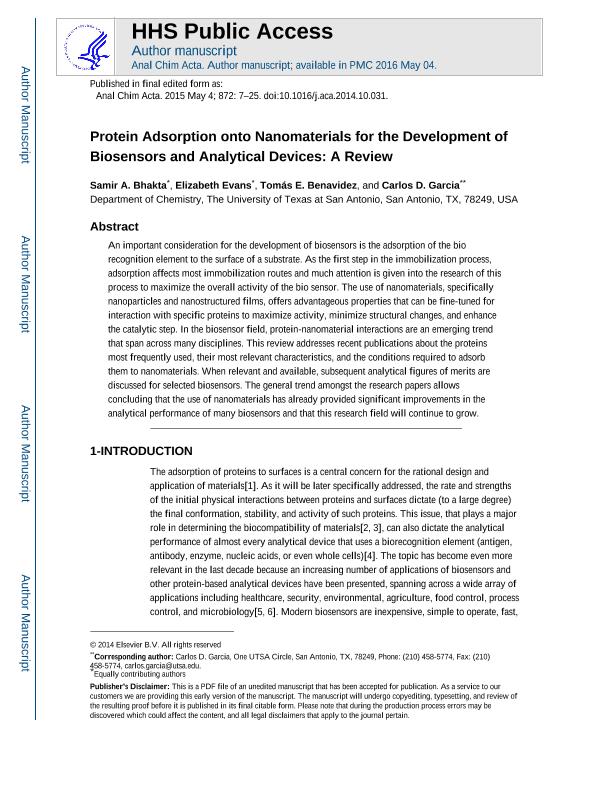Mostrar el registro sencillo del ítem
dc.contributor.author
Bhakta, Samir A.
dc.contributor.author
Evans, Elizabeth
dc.contributor.author
Benavidez, Tomás Enrique

dc.contributor.author
Garcia, Carlos D

dc.date.available
2018-08-09T21:57:22Z
dc.date.issued
2015-05-04
dc.identifier.citation
Bhakta, Samir A.; Evans, Elizabeth; Benavidez, Tomás Enrique; Garcia, Carlos D; Protein adsorption onto nanomaterials for the development of biosensors and analytical devices: A review; Elsevier Science; Analytica Chimica Acta; 872; 4-5-2015; 7-25
dc.identifier.issn
0003-2670
dc.identifier.uri
http://hdl.handle.net/11336/54920
dc.description.abstract
An important consideration for the development of biosensors is the adsorption of the biorecognition element to the surface of a substrate. As the first step in the immobilization process, adsorption affects most immobilization routes and much attention is given into the research of this process to maximize the overall activity of the biosensor. The use of nanomaterials, specifically nanoparticles and nanostructured films, offers advantageous properties that can be fine-tuned to maximize interactions with specific proteins to maximize activity, minimize structural changes, and enhance the catalytic step. In the biosensor field, protein-nanomaterial interactions are an emerging trend that span across many disciplines. This review addresses recent publications about the proteins most frequently used, their most relevant characteristics, and the conditions required to adsorb them to nanomaterials. When relevant and available, subsequent analytical figures of merits are discussed for selected biosensors. The general trend amongst the research papers allows concluding that the use of nanomaterials has already provided significant improvements in the analytical performance of many biosensors and that this research field will continue to grow.
dc.format
application/pdf
dc.language.iso
eng
dc.publisher
Elsevier Science

dc.rights
info:eu-repo/semantics/openAccess
dc.rights.uri
https://creativecommons.org/licenses/by-nc-nd/2.5/ar/
dc.subject
Adsorption
dc.subject
Proteins
dc.subject
Nanomaterials
dc.subject
Biosensors
dc.subject
Oxidase
dc.subject.classification
Otras Ciencias Químicas

dc.subject.classification
Ciencias Químicas

dc.subject.classification
CIENCIAS NATURALES Y EXACTAS

dc.title
Protein adsorption onto nanomaterials for the development of biosensors and analytical devices: A review
dc.type
info:eu-repo/semantics/article
dc.type
info:ar-repo/semantics/artículo
dc.type
info:eu-repo/semantics/publishedVersion
dc.date.updated
2018-07-30T15:24:21Z
dc.journal.volume
872
dc.journal.pagination
7-25
dc.journal.pais
Países Bajos

dc.journal.ciudad
Amsterdam
dc.description.fil
Fil: Bhakta, Samir A.. University of Texas; Estados Unidos
dc.description.fil
Fil: Evans, Elizabeth. University of Texas; Estados Unidos
dc.description.fil
Fil: Benavidez, Tomás Enrique. Consejo Nacional de Investigaciones Científicas y Técnicas. Centro Científico Tecnológico Conicet - Córdoba. Instituto de Investigaciones en Físico-química de Córdoba. Universidad Nacional de Córdoba. Facultad de Ciencias Químicas. Instituto de Investigaciones en Físico-química de Córdoba; Argentina. University of Texas; Estados Unidos
dc.description.fil
Fil: Garcia, Carlos D. Consejo Nacional de Investigaciones Científicas y Técnicas. Centro Científico Tecnológico Conicet - Córdoba. Instituto de Investigaciones en Físico-química de Córdoba. Universidad Nacional de Córdoba. Facultad de Ciencias Químicas. Instituto de Investigaciones en Físico-química de Córdoba; Argentina. University of Texas; Estados Unidos
dc.journal.title
Analytica Chimica Acta

dc.relation.alternativeid
info:eu-repo/semantics/altIdentifier/doi/https://www.ncbi.nlm.nih.gov/pmc/articles/PMC4405630/
dc.relation.alternativeid
info:eu-repo/semantics/altIdentifier/doi/http://dx.doi.org/10.1016/j.aca.2014.10.031
dc.relation.alternativeid
info:eu-repo/semantics/altIdentifier/url/https://www.sciencedirect.com/science/article/pii/S0003267014012860
Archivos asociados
